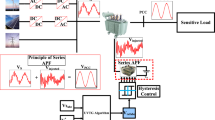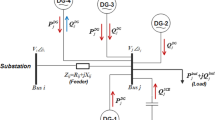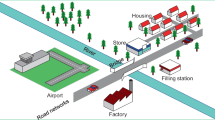Abstract
The independent system operator (ISO) is a key element in the deregulated structure with one of the responsibilities of transmission congestion management (CM). The ISO opts market based solutions to manage congestion receiving bids from generation companies (GENCOs) as well as distribution companies (DISCOMs) to reschedule their generation and relocate demand. The nodal prices increases during the congestion hours and the demand response to nodal prices will be an effective tool for the control of congestion. In this paper, demand response-based CM has been proposed for a mix of pool and bilateral electricity market model. The linear bid curves have been considered for demand bids to respond to the congestion in the network. The bilateral demand has been obtained with minimum deviations in their preferred schedule. The impact of flexible alternating current transmission system (FACTS) devices viz static var compensator (SVC) and thyristor controlled series compensator (TCSC) has also been considered for demand management during congestion. Multi-line congestion cases have been considered to study the impact on demand response without and with FACTS devices. The proposed approach has been tested on the IEEE 24 bus test system.
Similar content being viewed by others
References
Shahidepour M, Alomoush M. Restructured Electrical Power Systems, Operation, Trading, and Volatility. New York: Marcel Dekker, Inc., 2001
Singh H, Hao S, Papalexopoulos A. Transmission congestion management in competitive markets. IEEE Transactions on Power Systems, 1998, 13(2): 672–680
Bompard E, Carpenato E, Chicco G, Gross G. The Role of load demand elasticity in congestion management and pricing. In: Proceedings of IEEE PES 2000 Summer Meeting. Seattle, 2000, 2229–2234
Hao S, Shirmohammadi D. Congestion management with Ex Ante pricing for decentralized markets. IEEE Transactions on Power Systems, 2002, 17(4): 1030–1036
Alomoush M I, Shahidehpour S M. Fixed transmission rights for zonal congestion management. IEEE Proceedings. Generation, Transmission and Distribution, 1999, 146(5): 471–476
Alomoush M I, Shahidehpour S M. Generalized model for fixed transmission rights auction. Electric Power Systems Research, 2000, 54(3): 207–220
Shirmohammadi D, Wollenberg B, Vojdani A, Sandrin P, Pereira M, Rahimi F, Schneider T, Stott B. Transmission dispatch and congestion management in the emerging energy market structures. IEEE Transactions on Power Systems, 1998, 13(4): 1466–1474
Fang R S, David A K. Transmission congestion management in an electricity market. IEEE Transactions on Power Systems, 1999, 14(3): 877–883
Fang R S, David A K. Optimal dispatch under transmission contracts. IEEE Transactions on Power Systems, 1999, 14(2): 732–737
Srivastava S C, Kumar P. Optimal power dispatch in deregulated market considering congestion management. In: Lai L L, ed. Proceedings of International Conference on Electric Utility Deregulation and Restructuring and Power Technologies, London: IEEE, 2000, 53–59
Christie R D, Wollenberg B F, Wangstien I. Transmission management in the deregulated environment. Proceedings of the IEEE, 2000, 88(2): 170–195
Bompard E, Correia P, Gross G, Amelin M. Congestionmanagement schemes: A comparative analysis under a unified framework. IEEE Transactions on Power Systems, 2003, 18(1): 346–352
Kumar A, Srivastava S C, Singh S N. Congestion management in competitive power markets-A bibliographical survey. Electric Power Systems Research, 2005, 76(1–3): 153–164
Kumar A, Srivastava S C, Singh S N. A zonal congestion management approach using real and reactive power rescheduling. IEEE Transactions on Power Systems, 2004, 19(1): 554–562
Kumar A, Srivastava S C, Singh S N. A zonal congestion management approach using AC transmission congestion distribution factors. Electric Power Systems Research, 2004, 72(1): 85–93
Huang G M, Yan P. TCSC and SVC as re-dispatch tools for congestion management and TTC improvement. In: Proceedings of IEEE Power Engineering SocietyWinter Meeting. New York, 2002, 660–665
Yesuratnam G, Pushpa M. Congestion management for security oriented power system operation using generation rescheduling. In: Proceedings of IEEE 11th International Conference on Probabilistic Methods Applied to Power Systems (PMAPS). Singapore, 2010, 287–292
Albadi M H, El-Saadany E F. A summary of demand response in electricity markets. Electric Power Systems Research, 2008, 78(11): 1989–1996
Affonso C M, da Silva L C P. Potential benefits of implementing load management to improve power system security. International Journal of Electrical Power & Energy Systems, 2010, 32(6): 704–710
Yousefi A, Nguyen T T, Zareipour H, Malik O P. Congestion management using demand response and FACTS devices. International Journal of Electrical Power & Energy Systems, 2012, 37(1): 78–85
Kumar A, Sekhar C. DSM based congestion management in pool electricity markets with FACTS devices. Energy Procedia, 2012, 14(1): 94–100
Brooke A, Kendrick D, Meeraus A, Raman R, Rasenthal R E. A User’s Guide (GAMS Software). Washington: GAMS Development Corporation, 1998
Ferris M C. MATLAB and GAMS: interfacing optimization and visualization software. 1999-05-26, http://pages.cs.wisc.edu/~ferris/matlabgams.pdf
Subcommittee P, 0. IEEE Reliability Test System. IEEE Transactions on Power Apparatus and Systems, 1979, PAS-98(6): 2047–2054
Gyugyi L, Hingorani N G. Understanding FACTS: Concept and Technology of Flexible AC Transmission System. Piscataway, NJ: IEEE Press, 2001
Acha E, Fuerte-Esquivel C R, Ambize-Perez H, Angeles-Camacho C. FACTS: Modelling and Simulation in Power Networks. New York: John Wiley & Sons, 2002
Sharma A K, Chanana S. New multi-objective optimization problem for secure bilateral transaction determination with UPFC in hybrid electricity markets. Electric Power Components and systems, 2008, 36(6): 555–574
Grossmann I E, Viswanathan J, Vecchietti A, Raman R, Kalvelagen E. CONOPT Solver. Washington D C: GAMS Development Corporation, 2002
Grossmann I E, Viswanathan J, Vecchietti A, Raman R, Kalvelagen E. DICOPT: A Discrete Continuous Optimization Package. Washington D C: GAMS Development Corporation, 2003
Author information
Authors and Affiliations
Corresponding author
Rights and permissions
About this article
Cite this article
Kumar, A., Sekhar, C. Demand response based congestion management in a mix of pool and bilateral electricity market model. Front. Energy 6, 164–178 (2012). https://doi.org/10.1007/s11708-012-0187-9
Received:
Accepted:
Published:
Issue Date:
DOI: https://doi.org/10.1007/s11708-012-0187-9




